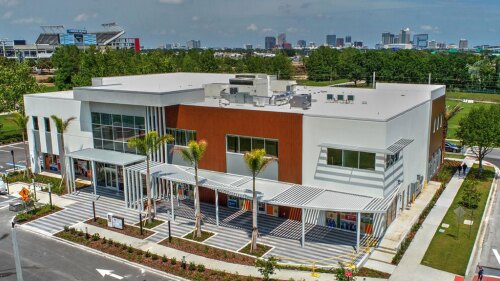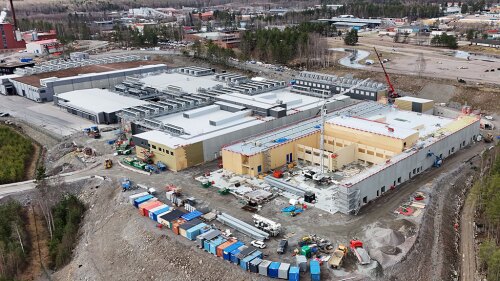Brussels is a city with scars—the legacy of bruxellisation—and a city with new ambition: to become Europe’s first “circular” (i.e. zero waste) capital by 2030. A surplus of vacant offices, urgent housing needs, a growing and diverse population, and dense policy layers made it the ideal laboratory for the Holcim Foundation Fellowship’s latest edition, co-led by Olaf Grawert and Josiane Schmidt from ETH Zurich’s station+ chair. I served as the Foundation’s lead with support from Luisa Pastore. Over two weeks, early-career Fellows from across Europe tested a simple question with far-reaching implications: what incentives would make reuse the default?
The Fellows immersed themselves in Brussels’ built environment—from ZIN and OXY to the Cosmopolitan and KANAL (future Centre Pompidou)—while meeting architects, contractors, developers, policy advocates, and financiers (including &bogdan, 51N4E, noAarchitecten, Democo Group, Whitewood Asset Management, BPIE, and others). They also stepped inside the European Parliament and held a discussion at the European Commission to understand how multilevel governance shapes change across the continent.
Why incentives—and why now?
The construction sector accounts for roughly 40 percent of carbon dioxide emissions and 36 percent of EU waste. At current rates, Europe would need to triple its renovation pace to meet 2050 goals—making adaptive reuse not only a climate imperative but an economic one that alleviates pressing housing needs. The Fellowship framed this as a systems challenge: align incentives across the “chain of space production” so that policy, finance, and culture pull in the same direction.
The Fellows’ diagnosis was blunt: the sector is fragmented, risk-averse, and structurally biased toward new build. Architects are given limited agency; contractors join too late to influence sustainable methods; capital markets optimize for exchange value over use value; and policy cycles are short relative to transformation timelines.
A practical, scalable playbook for all stakeholders
In response, the cohort produced a practical set of incentives designed to work across stakeholder groups rather than addressing each in isolation. The proposal is organized under three themes that must be coordinated in tandem—regulatory, financial, and socio-cultural—with implementation staged at EU, national, and local levels on a timeline to 2050.
1) Regulatory incentives
● Offices for renovation. City hubs that align departments and market actors, maintain an open building dataset (passports, condition, embodied carbon), and run a project help desk—turning information and coordination into delivery.
● Fast-track permitting for reuse. Priority lanes for renovation with reviews tailored to phased design, circular materials, and temporary uses—reducing “permit risk” and financing costs.
● Digital infrastructure. Open, centralized databases for building passports, condition assessments, and vacancy signals—interoperable with life-cycle assessment (LCA) tools and material marketplaces—to convert uncertainty into bankable pipeline.
● Physical infrastructure. Material banks and appraisal/processing hubs that make reclaimed components reliable at scale; EU-level minimums for recovery and reuse quality; municipal logistics to match.
● Procurement reform. Use public projects to lead: require early contractor involvement and delivery models (integrated project delivery/design-build-finance-maintain) that bring builders, suppliers, and deconstruction specialists upstream, where circularity decisions matter most.
2) Financial incentives
● ESG-aligned capital. Tie favorable capital and regulatory treatment to demonstrated renovation performance (such as life-cycle thresholds, minimum reuse shares, transparent LCA reporting) so investors can price risk consistently.
● Risk-reduction instruments. Pair fast-track permits and data transparency with municipal guarantees or EU-backed credit enhancements for first-mover projects in target districts.
● Tax and fee alignment. Re-balance taxes and municipal fees so renovation isn’t penalized versus demolition/new build; reward projects that deliver measurable circular outcomes.
3) Socio-cultural incentives
● Education and upskilling. Fund applied R&D, practitioner guidelines, and training for reuse methods, selective deconstruction, and design for adaptability. Capacity is an incentive.
● Soft power and citizen platforms. Use awards, media, and simple “one-stop” portals that make choices legible and normalize renovation as the default option.
Brussels’ conditions made it the right candidate for the reuse prototype: abundant office stock from the 1970s through the 1990s, political density, a circularity (zero waste) agenda, and visible precedents that model trade-offs. Dialogues with design teams, investors, and builders anchored the work in decisions that practitioners actually face: when to strip back to structure, how to handle irregular grids and cores, what to do with façades, how to phase tenants and works, how to source reclaimed components at the right quality and time. Sessions at the European Commission and exchanges with policy institutes connected these choices to pending regulation, taxonomy debates, and implementation realities.
A systems approach across four cities
The Fellowship in Brussels built on questions we’ve tested since our Fellowships in New York, Mexico City, and London—each city adding a piece to the puzzle.
New York taught us that decarbonization at scale relies on predictable rules, shared risk, and delivery models that align incentives. Brussels turns those lessons into incentive design (cutting permit risk, standardizing performance, bringing builders upstream, etc.).
Mexico City reminded us that durable change starts with context and community—land, water, materials, and social license. Brussels carried this forward by treating culture as infrastructure: citizen platforms, awards, and “one-stop” support that make choices legible.
London reframed planning as process over product. Brussels put this into operation via Local Offices for Renovation, fast-track pathways, and shared data that redefine what “good” looks like over time.
Across all four, the Fellowship itself has evolved—and kept learning along the way—into a mobile strategic foresight platform: a city-to-city way of learning where each cohort tests ideas, refines it with practitioners, and leaves behind tools others can use. That arc—from New York to Mexico City, London, and now Brussels—completes this cycle and carries forward a community ready to apply its lessons.
The human thread
Behind the frameworks are people—Fellows, mentors, city officials, builders, designers, and community voices—who showed up with curiosity and generosity. The next generation is not waiting for permission; they’re learning how to listen across disciplines, translate values into practice, and work the seams between policy, finance, and delivery. Their confidence—and the relationships formed along the way—is the real conveyor from city to city.
Next up: Zurich (December). Select fellows from the four fellowships will convene for the Emerging ChangeMakers Retreat with the Holcim Foundation and collaborators from the UN Global Compact, McKinsey Global Institute, Arup, EBP, and EPFL.









